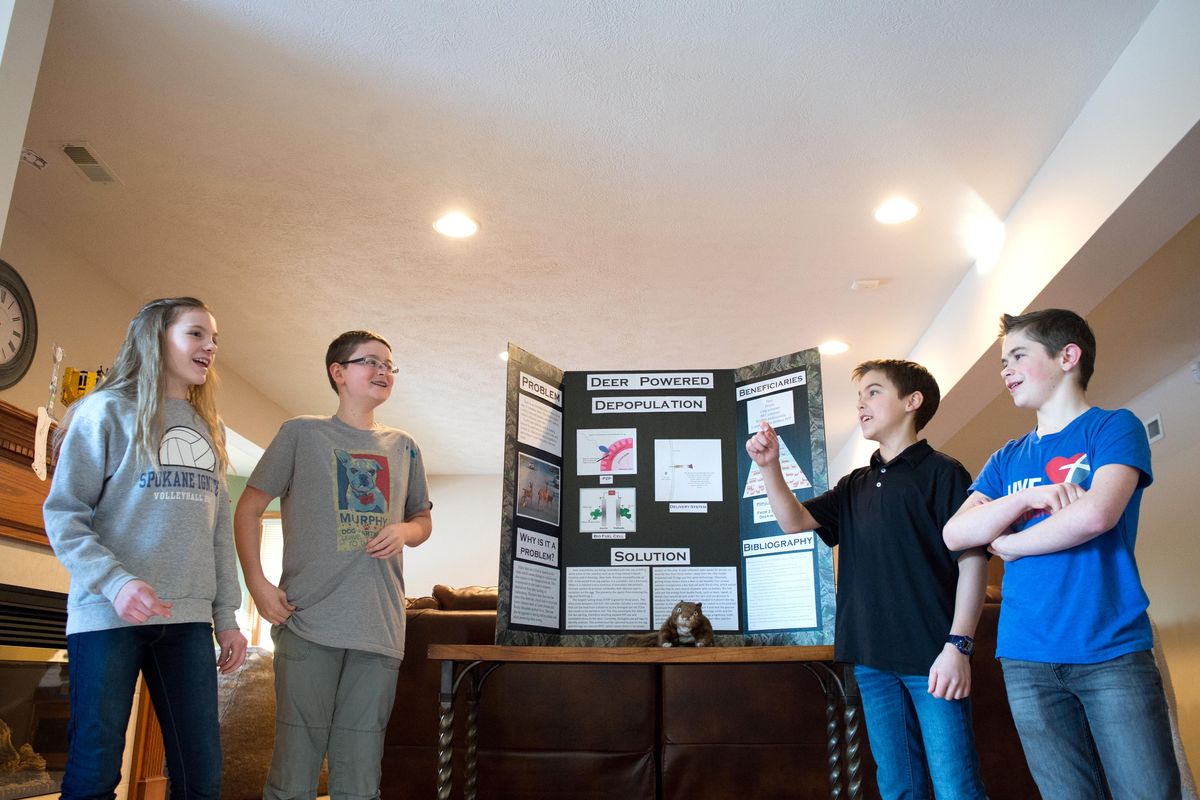Central Valley middle school students score a regional win with deer contraceptive tracker

In a basement room of a Spokane Valley home, four middle school students are developing means to influence deer reproduction. Specifically, how to stop it.
Their invention is a delivery system for porcine zona pellucida, an immunocontraceptive extracted from the ovaries of pigs. The students have designed a device that could inject the chemical via a dart gun, while simultaneously tracking when the deer was last injected.
Perhaps the most unusual feature of the students’ invention is a tracking device included in the PZP delivery. The device, which would travel on the tip of a dart and embed in the deer’s skin, can track when an animal was last injected with the contraceptive and would be powered by biofuel technology.
Their invention won the Eastern Washington FIRST Lego League State Championship on Jan. 1. They hope to patent the idea.
The four will now go to Houston to compete in the FIRST Lego League Championship from April 19-22. They will go up against about 100 teams in their age bracket. Overall, there will be another 600 teams at the championships. This year’s theme is Animal Allies.
The Spokane Valley team is comprised of 12 and 13 year olds: Deen Abou-Harb, Blake Busch, Ryan Cox and Brigitta Maughan.
The four students, who all live near the Dishman Hills Conservation Area, are familiar with the issue of deer overpopulation. On a sunny February day, three or four deer stood close to the basement the students were working in, as if illustrating the need for intervention.
Sara Hansen, the Washington Fish and Wildlife Department’s statewide deer specialist, reviewed the group’s presentation and liked what she saw.
“They really did a good job, and it was impressive to have kids that age really think a problem through from beginning to end,” she said.
Although immunocontraception hasn’t been a particularly useful tactic for controlling deer populations in the past, Hansen said, the group’s implementation of biofuel technology to help track the deer is innovative.
“It is something that we haven’t ever used in our field before,” she said.
Because of the technology and the power it generates, the device’s signal can reach farther. Current RFID tags are passive, meaning they have to be pinged by another device, usually from a distance of 3 meters or closer.
That would make it easier to see which deer received a dose of PZP and which hadn’t.
“Our chip is built so we don’t waste PZP and we know which deer have been darted, so we aren’t darting at random like people are now,” Busch said.
The process has been a learning process for everyone, said Kristy Busch, the team’s coach and Blake’s mother.
“No, I did not know I was going on this journey with middle schoolers,” she said. “We learned about reproduction and immunocontraception.”
“At first, we got PZP and PCP confused,” Cox said. Blake Busch quickly interjected, “Then we learned about angel dust.”
Although many school districts offer school-sponsored teams, Central Valley doesn’t, Kristy Busch said. Instead, they started their own team. Busch said going to Houston will cost the team roughly $10,000 in travel and registration fees. The team has started a GoFundMe to pay for the trip.
Suburban deer overpopulation can be a problem statewide, said Hansen, the deer specialist. However, what is considered too many deer varies from community to community.
“We really do try to get the community as involved as possible so they really know the problem but really own the solution to it,” she said.
Although the invention is an important part of how the team will do in the FIRST Lego League Championship, it’s only one portion. The team also was judged on the performance of a robot they designed that navigates an obstacle course and how well the team worked together.